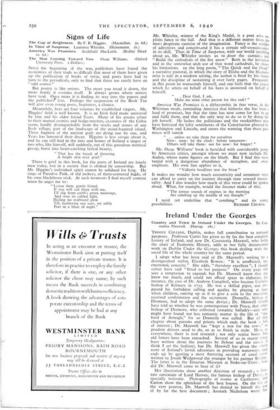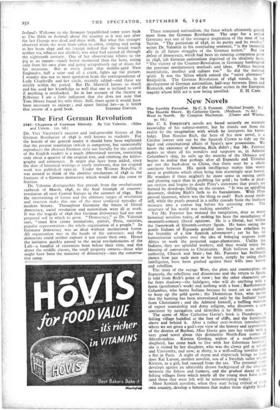Ireland Under the Georges
Country and Town in Ireland Under the Georges. By Con- stantia Maxwell. (Harrap. as.) TRINITY COLLEGE, Dublin, makes full contribution to national purposes. Professor Curtis has given us by far the best complete history of Ireland, and now Dr. Constantia Maxwell, who holds the chair of Economic History, adds to her fully documented work on Dublin Under the Georges this book dealing with the social life of the whole country for the same period.
I adopt what has been said of Dr. Maxwell's writing by .1 distinguished stylist, Elizabeth Bowen: " It is unaffected, un- emotional, concrete." She adds, " therefore excellent "; I should rather have said " fitted to her purpose." On every page one sees a temptation to expand; but Dr. Maxwell knew that she knew too much, and could not afford space to elaborate, for instance, the case of Dr. Andrew Campbell, who became Catholic bishop of Kilmore in 1753. He was a skilled piper, and dis- guised his forbidden calling and quality by playing at fairs when children, coming up as if to give a coin to the music:an. received confirmation and the sacrament. Donnelly, bishop 01 Dromore, had to adopt the same device ; Dr. Maxwell should have told us whether he was contemporary with Percy, that other bishop of Dromore, who collected romantic balladry—and who might have found not less romantic matter in the life of "the bard of Armagh," for so Donnelly was called. But all this chapter about parsons and priests which ends the book is full of interest ; Dr. Maxwell has " kept a trot for the town," as prudent drivers used to do, so as to finish in style. Here, as everywhere, there is real research ; not only scarce books but old letters have been ransacked. Several of us in recent times have written about the journeys by flyboat and the canals (I think I set the fashion), but Dr. Maxwell has given the whole story of Ireland's lavish adventure in providing waterways. and, ends up by quoting a most flattering account of canal travel written to Josiah Wedgwood the younger by his partner Byerley1 The letter is in the Etrurian Museum at Stoke-on-Trent ; hov. did Dr. Maxwell come to hear of it?
Her illustrations show another direction of research ; a firs!" rate caricature of Lord Hervey, the famous bishop of Derry, is specially welcome. Photographs of rooms at Castletown. and Carton show the splendour of the best houses. On the life of the very poorest, Dr. Maxwell has denied to herself the use of by far the best document ; Asenath Nicholson wrote her Ireland's Welcome to the Stranger (republished some years back as The Bible in Ireland) about the country as it was just after the last George was dead and done with. But what this stranger observed when she went from cabin to cabin, sleeping and eating as her hosts slept and ate (except indeed that she would touch neither tea, tobacco nor alcohol), was what had existed all through the eighteenth century. One of her observations relates to the pig as an inmate—much better mannered than the hens, eating only from his own plate and going scrupulously out of doors for his occasions. But at every point that middle-aged New Englander, half a saint and all a crank, lights up the picture. I wonder also not to meet .quotation from the correspondence of Lady Charleville and her circle, recently edited—and these are strictly within the period. But Dr. Maxwell knows so much and has used her knowledge so well that one is inclined to cavil if anything is overlooked. So in her account of the theatre at Kilkenny I am a little indignant that she does not note that Tom Moore found his wife there. Still, there again it would have been necessary to enlarge ; and space limited her—as it limits



























 Previous page
Previous page